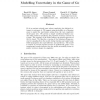528 search results - page 56 / 106 » Causal inference using the algorithmic Markov condition |
BMCBI
2006
14 years 10 months ago
2006
Background: Hidden Markov Models (HMMs) have been extensively used in computational molecular biology, for modelling protein and nucleic acid sequences. In many applications, such...
186
click to vote
POPL
2006
ACM
15 years 10 months ago
2006
ACM
The movement to multi-core processors increases the need for simpler, more robust parallel programming models. Atomic sections have been widely recognized for their ease of use. T...
ICML
2004
IEEE
15 years 3 months ago
2004
IEEE
We introduce a new perceptron-based discriminative learning algorithm for labeling structured data such as sequences, trees, and graphs. Since it is fully kernelized and uses poin...
NIPS
2004
14 years 11 months ago
2004
Go is an ancient oriental game whose complexity has defeated attempts to automate it. We suggest using probability in a Bayesian sense to model the uncertainty arising from the va...
ICFP
2004
ACM
15 years 9 months ago
2004
ACM
Useful type inference must be faster than normalization. Otherwise, you could check safety conditions by running the program. We analyze the relationship between bounds on normali...

